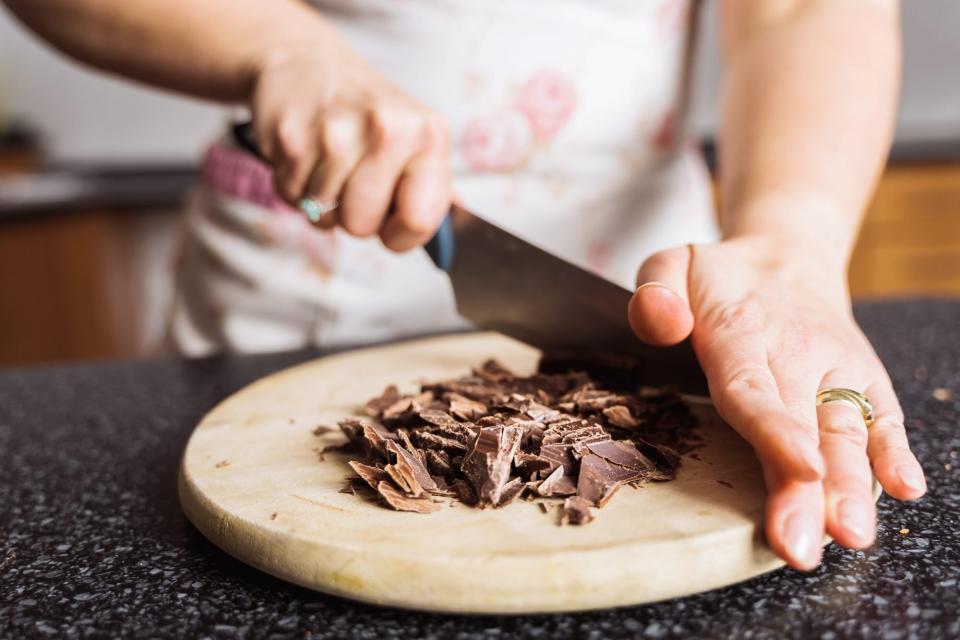Should You Use Chocolate Chips or Chopped Chocolate When Making Chocolate Chip Cookies?

It's hard to find a dessert that beats the humble chocolate chip cookie, but in a quest to improve what many say is already perfect, some assert that the very chocolate chip—the cookie's namesake—is not what you should be using in recipes for these treats. What could be even better than chocolate chips, you may wonder? The answer for many bakers is simply chopped chocolate. Cookies boasting irregularly-shaped, gooey, perfectly imperfect shards of chocolate are popping up all over social media, and for good reason.
Related: How to Make Chocolate Ganache, Our Favorite Two-Ingredient Recipe
Chocolate Chips Versus Chocolate Bars
When it comes to chopped chocolate versus chips, the difference is more about the ingredient proportions rather than different ingredients themselves, says Anne Wolf, a chocolatier at EHChocolatier in Cambridge, Massachusetts. Chocolate usually contains a combination of cocoa butter and cocoa mass, sugar, lecithin (an emulsifier, usually soy-based and sometimes sunflower-based), and sometimes dairy, vanilla, and/or other flavorings, according to Wolf. A product like chocolate chips (whose goal is to keep its chip shape throughout baking) will contain less cocoa butter (if any) and more lecithin. In comparison, a bar of chocolate will boast the opposite ratio, containing less lecithin and more cocoa butter.

Patrik Molcan / Getty Images
Is It Worth It?
Because cocoa butter is what provides that melty, silky mouthfeel we know and love in chocolate, bar chocolate, which contains a greater proportion of this ingredient, will melt smoothly and have a preferable mouthfeel upon eating. Also, Wolf noted, using bar chocolate that you chop yourself "gives you so much more flexibility to pick a chocolate that you really love." While the selection of chocolate chips at the grocery store can be limiting, there are so many more options of bar chocolate out there from which to choose, so you can really tailor your baked goods to your specific chocolate preferences (and get creative with unique bars!). Furthermore, the classic chocolate chip shape is "not necessarily the ideal shape for the tongue or mouth," Wolf noted, and morsels are shaped the way they are due to manufacturing processes, not because it was ever determined to be the best shape for mouthfeel. When you chop chocolate yourself, you get irregular pieces that disperse throughout your batter more unpredictably, providing a more dynamic and interesting eating experience. Some bites will have larger chunks, and some bites will contain smaller shards, and that element of unknown is arguably more intriguing.
Of course, it all comes down to personal preference. Chocolate chips are a convenient, budget-friendly pantry item and, if you like the regularity of that perfect round chip evenly dispersed throughout your baked goods, it's still a great option to have on hand (and will certainly decrease your kitchen time), says Wolf. Bar chocolate is not typically sold pre-chopped, so it will require an extra step when baking with it, but if you're willing to spend the extra few minutes in the kitchen, you will be rewarded with a upgraded "chocolate chip" cookie. What's more, we really do think you'll wonder why you haven't been making cookies (and other baked goods) this way all along.
Making the Chip-to-Chop Swap
Making the change is fairly straightforward. First, select your bar chocolate. None are off-limits to Wolf, who says you can apply this swap to virtually any type of baked good recipe that calls for chocolate chips. That said, she suggests not reaching for the most expensive of your favorite chocolate bars. Though small-batch, artisanal bars would be delicious baked into a cookie, they can distract from the chocolate flavor itself because there are so many other flavors going on in a baked good (think: brown sugar, nuts, coconut, vanilla extract). You might want to save pricier bars for eating on their own, in order to better savor the flavor independently and not let it get lost. That being said, you still want to choose good bar chocolate that you like; when in doubt, "cook with what you like to eat," suggests Wolf.
Once you've picked your chocolate, your next step is to chop it. For this, Wolf suggests using a serrated knife. However, she points out, you should avoid "sawing back and forth," and instead "use both of your hands and cut straight down." This way, the teeth of the serrated knife will help break the bar into smaller pieces, and fewer big chunks will go flying across your kitchen counter. Also, Wolf advises to not refrigerate or freeze chocolate ahead of time, as you will risk condensation and "water is chocolate's enemy." Keep your chocolate at cool-room temperature; any major fluctuations could cause it to come out of temper and change texture and stability, she notes.
Once you've chopped your chocolate into wonderfully uneven pieces, the next step will be measuring it. Make sure to actually weigh your ingredients, rather than simply substituting a cup amount of chopped pieces for a cup amount of chips ("when in doubt, weigh it out!" Wolf advises). You are likely to have volume differences when you make this kind of exchange, she warns, so put that kitchen scale to good use here to make sure you get the correct amount of chocolate into your recipe.